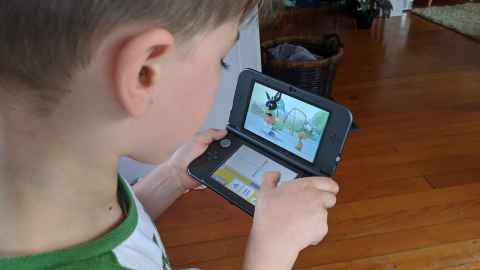Binocular-balanced movie viewing: a treatment for amblyopia (“lazy eye”)
This treatment aims to encourage the brain to use information from the two eyes together by blurring the image shown to the better-seeing eye.

Amblyopia or “lazy eye” is a condition that affects about 3% of children. Current treatments are only moderately effective and about half of children treated are left with residual vision problems that cannot be fully corrected with lenses. We want to see if a recently developed binocular-balanced movie-watching treatment can be effective for children (5-15 years) and adults (16+ years) with amblyopia in one eye. This binocular treatment was developed in the UK and was approved as a medical device in 2018. It is currently being tested in Phase II clinical trials in the UK. This treatment aims to encourage the brain to use information from the two eyes together by blurring the image shown to the better-seeing eye.
What's involved?
This study has two phases: Phase 1 involves wearing up-to-date prescription glasses or contact lenses (if needed) every day, and vision checks every 6 weeks. Once we confirm that you or your child’s vision is stable for at least 3 visits, we will then determine whether further treatment is still needed.
If you or your child enters Phase 2, we will loan you a handheld Nintendo device with customised binocular movies loaded on it for at-home treatment. The treatment involves watching movies or cartoons on the device for 1 hour per day, for 6-36 weeks. We will check you or your child’s progress every 6 weeks.
The study is being conducted at two sites:
- Grafton Campus University Optometry Clinic, 85 Park Road, Grafton.
- Anstice Optometrists, 10 Clyde Road, Ilam, Christchurch.
All vision assessments and the binocular treatment will be provided free of charge.
Eligibility criteria
- Reduced vision in one eye due to amblyopia and good vision in the other eye, even after correction with appropriate glasses or contact lenses.
- Amblyopia associated with anisometropia (a large difference in prescription between eyes), strabismus (an eye-turn or misalignment), or both of these conditions.
- Healthy eyes with no other causes of vision loss apart from amblyopia.
- If you or your child has strabismus (an eye-turn), the angle must be 10 prism dioptres or smaller when viewing the handheld device. Binocular treatment is not suitable for people with large angle eye turns or people who are prone to double vision.
- Eye muscle surgeries for strabismus and/or some types of corneal laser surgery are okay, but we exclude any surgeries that have altered any parts inside the eyes e.g. cataract or glaucoma surgeries.
- No current amblyopia treatment apart from wearing lenses. If you are/your child is currently performing active treatments such as patching, vision training, atropine eye drops, or wearing blurring filters over lenses, please contact your prescribing clinician for advice.
Contact
For more information about this study or to take part, please read the appropriate documents below and contact:
Dr Tina Gao
Study Coordinator
Email: t.gao@auckland.ac.nz
Phone: 09 923 2955
Kim Stedman
Christchurch site clinical contact
Email: kim@anstice.co.nz
Phone: 03 343 3909
For clinicians, detailed definitions for eligibility and referral information can be found in the “Information for Clinicians” document below.
Interested participants and parents/guardians are encouraged to consult with their current optometrist or ophthalmologist before entering the study.
Related documents—Auckland
Related documents—Christchurch
Approved by the University of Auckland Human Participants Ethics Committee on 26 August 2019 for six years, Reference Number 023137. Ethics updated 13 October 2021, Reference number 20609.